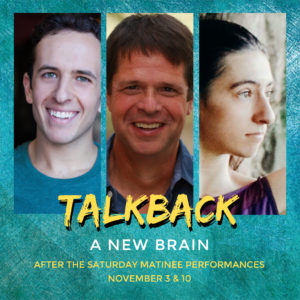A Note from the Dramaturg: A New Brain
Written by Nick Richardson
Arteriovenous malformation. (Say that three times fast!)
In the human body, arteries carry oxygen-rich blood from the heart to body tissue – in this case, the brain. The oxygen diffuses into the brain tissue through capillaries. These same capillaries then absorb carbon dioxide from the tissue, and veins carry the deoxygenated blood back to the heart. An arteriovenous malformation, or AVM, lacks this network of capillaries; instead, the arteries and veins link directly to each other, and the brain tissue does not receive proper oxygen.
AVMs may seem like an obscure topic for a musical (only about one percent of people experience them), but not for A New Brain’s composer, William Finn. As Finn battled his own AVM, his longtime collaborator James Lapine encouraged him to consider adapting his experiences into a production. The impetus to write struck after the fact, for Finn’s recovery from surgery unleashed a newfound optimism and creative energy. Despite this personal connection, Finn’s end product is a largely fictional musical sparsely peppered with autobiographical moments.
Lapine helped steer Finn away from a technical medical documentary to focus on the relationships between characters, constructing a tangled web of disparate lives. In this way, A New Brain falls nicely into Finn’s oeuvre of musicals that make traumatic events both personal and even humorous. His 1992 Tony-winner for Best Musical Falsettos brings the AIDS crisis home to a family unraveling their own wacky love square. The 25th Annual Putnam County Spelling Bee spotlights middle school students facing the best and worst of adolescence. A New Brain also demonstrates Finn’s signature witty wordplay, only this time in a completely sung-through format.
This show demands an attentive audience, one that can note all of its sonic and visual details. Look out for chromosomes, double helixes, and other biology-inspired shapes in Holly Stone’s choreography. The movement visually represents the inner workings of the brain at the molecular level. In Finn’s musical, the effects of the AVM result in a sort of double consciousness: one in the present, the other in a dream-like liminal space where work anxieties and family histories come alive. Frequently, these worlds collide and hallucinations populate the stage. This double consciousness allows for eclectic musical influences and physical vocabularies. These elements, along with a vivid lighting design, help distinguish the AVM-fueled fantasy scenes from scenes set in reality.
More than the all-too-familiar road-to-recovery narrative, A New Brain dramatizes an enduring question of our human existence: how do we make the most of our time here? For Finn, the answer is simple. He makes music. He encourages us to find our own music, and to play on!
Want to Learn More?

Join us for a post-show talkback with the creative team
of A New Brain!
After the Saturday matinee performances (11/3 and 11/10), dramaturg Nick Richardson will lead a discussion with director Tom Ossowski and choreographer Holly Stone. He’ll also host an open Q&A session with the audience. Admission is free with your ticket. We invite you to stay and learn more about this exciting musical: its themes, its history, the production process, and more.
__________________________
Nick Richardson is a second year MA Theatre Studies candidate. He earned his BA in Theatre with a minor in Spanish from FSU. He has presented original scholarship on musical theatre at national and international conferences. As a performer, Nick’s credits span opera, musical theatre, and film. Other dramaturgy credits at FSU include A Day in the Death of Joe Egg and the 2016 New Horizons Festival.